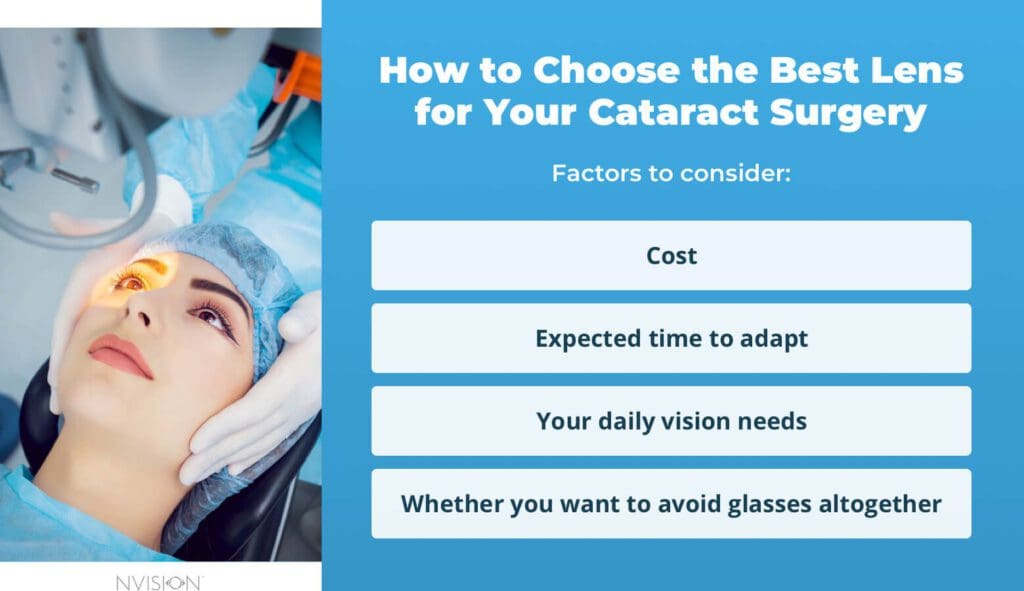Cataract Surgery Lens Options
Last Updated:

Article At a Glance
Considering cataract surgery? This article explains your lens options in simple terms:
- Monofocal IOLs: Correct vision at a single focal point, typically distance, requiring reading glasses for near tasks.
- Toric IOLs: Designed to correct astigmatism, improving distance vision but may still necessitate reading glasses.
- Multifocal IOLs: Provide clear vision at multiple distances, reducing dependence on glasses.
- Accommodative IOLs: Mimic the eye’s natural focusing ability, offering a continuous range of vision with minimal need for glasses.
- PanOptix Trifocal IOLs: Offer excellent vision at near, intermediate, and distance ranges, minimizing the need for glasses.
- Light Adjustable Lenses (LALs): Allow post-surgery customization of lens power using UV light treatments for tailored vision correction.
Table of Contents
Choosing the right intraocular lens (IOL) for your cataract surgery is an important decision that can dramatically improve your vision and quality of life. The human eye is an incredible and complex organ, with a natural lens that focuses light onto the retina at the back of the eye. This lens is made up of water and protein, and it’s so clear that you can see through it. In fact, the lens is the only part of the human body that doesn’t have blood vessels!
When this lens becomes cloudy due to cataracts, it’s time to consider replacing it with an artificial IOL implant.
Intraocular Lenses (IOLs): Artificial Lenses For Cataracts Surgery
Intraocular lenses serve a very similar function to the removed natural lens – it adjusts to incoming light and focuses images on your retina. However, there are many types of IOLs available, each with unique features and benefits that must be carefully considered. Factors like your lifestyle, visual needs, cost, and any pre-existing eye conditions will help determine the best IOL for you. Discussing all the IOL options with your ophthalmologist is crucial to selecting the lens that will provide optimal vision and quality of life after your cataract surgery.
Selecting the appropriate lens implant involves careful consideration of several key factors, including your lifestyle, visual needs, cost, and any pre-existing eye conditions. For instance, Toric lenses are specifically designed for correcting astigmatism but can be costly.
You deserve clear vision. We can help.
With 135+ locations and over 2.5 million procedures performed, our board-certified eye surgeons deliver results you can trust. Your journey to better vision starts here.
Types of Lenses for Cataract Surgery
An intraocular lens, or IOL, serves a very similar function to the removed natural lens. It adjusts to incoming light and focuses images on your retina. There are many types of IOLs available, each with unique features and benefits.
Cataract surgery lens options include:
Monofocal IOLs
Monofocal lenses are the most common type of intraocular lens (IOL) used in cataract surgery. They correct vision at a single focal point, typically for distance. Patients who opt for distance lenses may still need glasses for reading after surgery with monofocal lens options.
Medical insurance, including Medicare, only covers basic lenses, which are typically monofocal lenses adjusted for the more distant depth-of-vision.
- Suitable for people of all ages who do not have significant astigmatism or other refractive issues.
- Suitable for people with severe dry eye who do not have significant astigmatism or other refractive issues.
- Suitable for people who had LASIK or similar surgery who do not have significant astigmatism or other refractive issues.
Premium Lenses
In contrast to monofocal IOLs, which are the most basic option that allow for clear, sharp vision at a particular distance, premium cataract surgery lens options include a range of advanced lens technologies that address specific refractive issues. As a result, these technologically advanced lenses provide better vision outcomes for patients. Premium cataract surgery artificial lenses include multifocal and accommodative lenses, which are designed to reduce dependence on glasses by providing vision correction at multiple distances.
Multifocal Lenses
Multifocal lenses have multiple focal points, allowing clear vision at near, intermediate, and distance ranges simultaneously. Examples include ReSTOR, Tecnis Multifocal, and PanOptix lenses.
While multifocal lenses aim to reduce dependence on glasses by correcting vision at multiple distances, they do not guarantee perfect uncorrected vision at near, intermediate and far. The degree of vision at each range can vary between lens designs and individual patients.
Toric Lenses
Toric lenses are cataract surgery lenses designed to correct astigmatism, incorporating two powers – one for crisp distance vision and one for astigmatism correction. These specialized intraocular lenses (IOLs) can enhance activities requiring clear distance vision, like driving, watching TV, and reading signs. However, some patients may still need reading glasses for near tasks. Consult your ophthalmologist to determine if toric lenses suit your visual needs and lifestyle.
Accommodative Lenses
Accommodative lenses are designed to shift position within the eye, allowing them to adjust focus. This unique feature provides a continuous range of clear vision, reducing your dependence on glasses. With accommodative lenses, you can enjoy a more natural, adaptable visual experience.
Light Adjustable Lens (LAL)
The Light Adjustable Lens (LAL) is a unique, customizable option that allows your ophthalmologist to fine-tune the lens power after your surgery using UV light. This innovative technology enables personalized vision correction without the need for additional procedures, potentially reducing your dependence on glasses.

You deserve clear vision. We can help.
With 135+ locations and over 2.5 million procedures performed, our board-certified eye surgeons deliver results you can trust. Your journey to better vision starts here.
Finding the Right Artificial Lens for Cataract Surgery
Here are some key steps you can consider prior to, and during, discussions with your doctor around cataract surgery lens options:
- Identify your vision needs and goals. Consider the activities you enjoy and want to be able to do clearly without glasses. This could include driving, reading, computer work, hobbies, etc.
- Assess your lifestyle and visual needs. Determine if you have astigmatism, dry eye, or had previous refractive surgery.
- Consider your age and visual changes that may occur over time. Multifocal and accommodative lenses may be more suitable for people starting in their 40s who want to reduce dependence on glasses.
- Prioritize the visual needs that are most important to you. Decide if you are willing to accept some tradeoffs in one area (like night vision) to get better vision in another area (like reading).
- Research the features and tradeoffs of different intraocular lenses. Understand the differences between monofocal, toric, multifocal, and accommodative lenses. Look into brands like PanOptix that offer advanced technology.
- Look at real-world examples of vision with different lenses. Many lens manufacturers provide sample images to give you an idea of what to expect in terms of clarity, depth of field, and visual disturbances.
- Understand what lens options are covered by your insurance. Most plans cover basic monofocal lenses, but there are additional out-of-pocket costs for premium lenses like multifocals or toric lenses. Check with your insurance provider to understand your coverage and out-of-pocket costs for different lens types.

Discuss your research and priorities with your doctor. They can provide guidance on the best lens options for your specific needs and help you make an informed decision.
By doing this research ahead of time, you’ll be better prepared to have a productive discussion with your doctor about the lens that will provide the best vision and quality of life for your unique situation. The key is to understand the options and your own needs so you can make the choice that is right for you.
Will Insurance Cover IOLs?
Always check the specifics of your insurance plan before choosing an IOL option. Even if cost is not a significant factor in your decision, you want to ensure you can take full advantage of the coverage available to you.
Will Private Insurance Cover IOLs?
Insurance usually covers cataract surgery and the standard IOL option, which is a monofocal lens. Alternative IOL options often aren’t covered, partly because they cost more than monofocal lenses, and it is usually possible to achieve a similar level of vision by using monofocal lenses combined with corrective eyewear, like glasses.
In many cases, your insurance plan may cover the cost of an IOL option up to the standard price of a monofocal lens and require you to pay the difference out of pocket.
Will Medicare Cover IOLs?
Medicare plans cover “conventional” IOLs, including the cost of buying the lenses and implanting them surgically. Many approved lenses are monofocal, but others are toric or multifocal.
Choose your IOL carefully, as picking the wrong one can mean paying for the entire process yourself. Your doctor should help you find one that’s right for your plan.
You deserve clear vision. We can help.
With 135+ locations and over 2.5 million procedures performed, our board-certified eye surgeons deliver results you can trust. Your journey to better vision starts here.
References
- Light-Sensitive Brain Pathways and Aging. (March 2016). Journal of Physiological Anthropology.
- Eye Health Statistics. American Academy of Ophthalmology.
- Cataracts. (January 2023). National Eye Institute.
- Vision 2020: The Cataract Challenge. (2000). Community Eye Health Journal.
- Cataracts Cause a Third of Worldwide Blindness. SEE.
- A Comparison of Clinical Outcomes and Optical Performance Between Monofocal and New Monofocal With Enhanced Intermediate Function Intraocular Lenses: A Case-Control Study. (October 2021). BMC Ophthalmology.
- Optimizing Outcomes With Multifocal Intraocular Lenses. (December 2017). Indian Journal of Ophthalmology.
- The Pros and Cons of Multifocal and Accommodating IOLs. (February 2008). ASCRS EyeWorld.
- Toric Intraocular Lens for Astigmatism Correction in Cataract Patients. (October 2017). Advanced Biomedical Research.
- Extended Depth-of-Field Intraocular Lenses: An Update. (June 2020). Asia-Pacific Journal of Ophthalmology.
- Medicare Vision Services. (August 2021). Centers for Medicare and Medicaid Services.
This content is for informational purposes only. It may have been reviewed by a licensed physician, but is not intended to serve as a substitute for professional medical advice. Always consult your healthcare provider with any health concerns. For more, read our Privacy Policy and Editorial Policy.